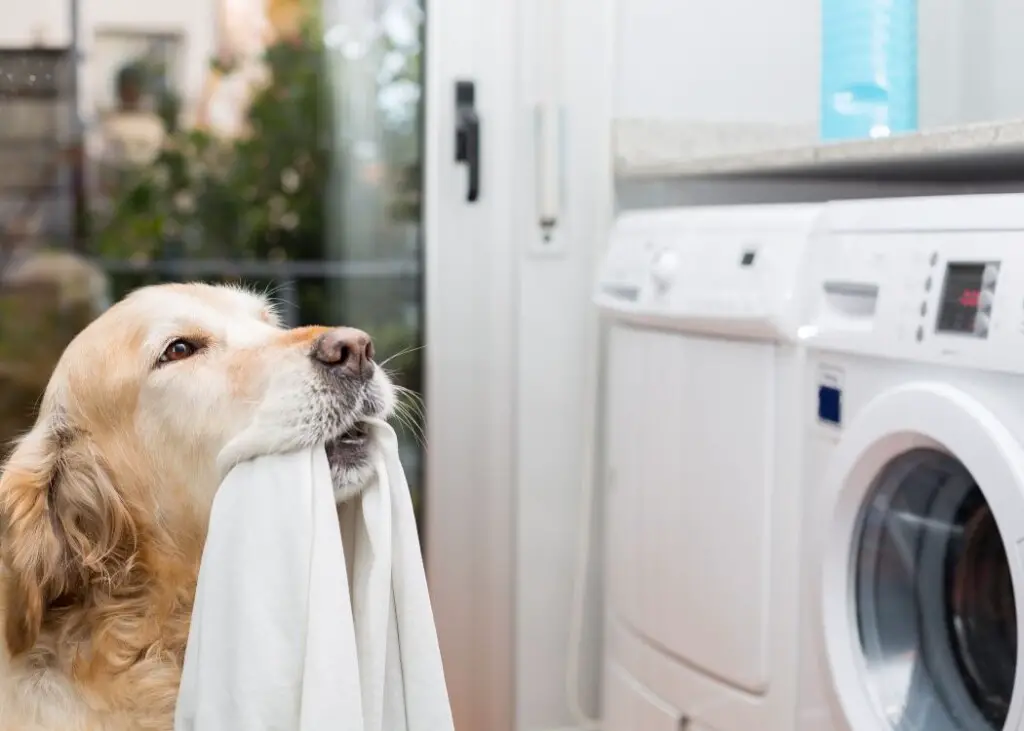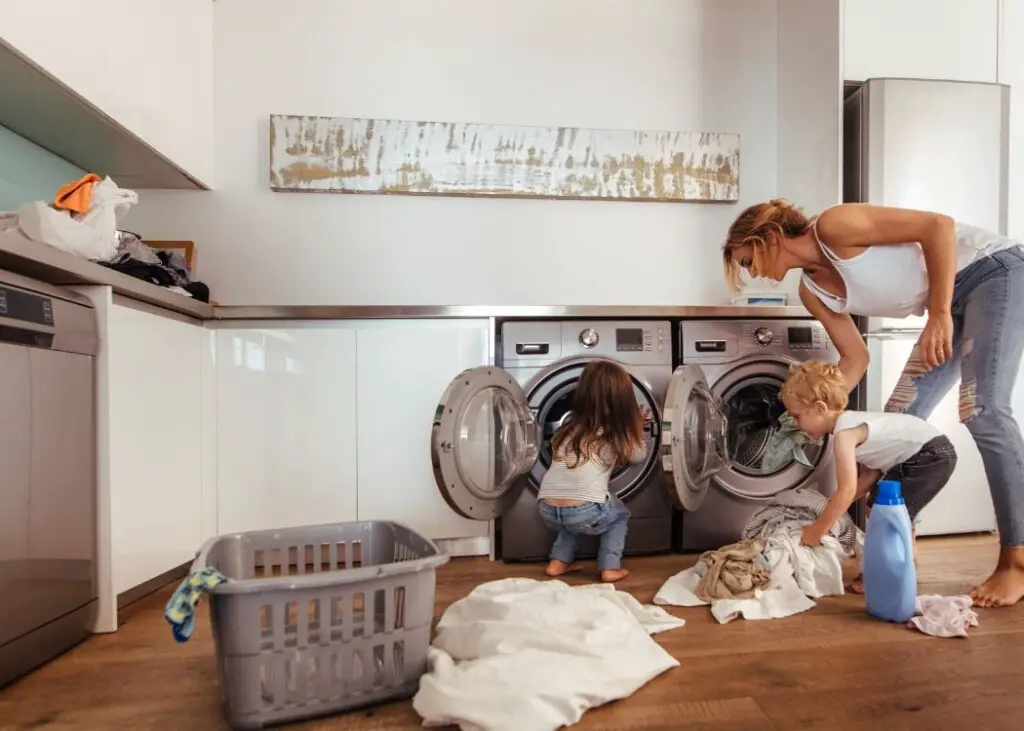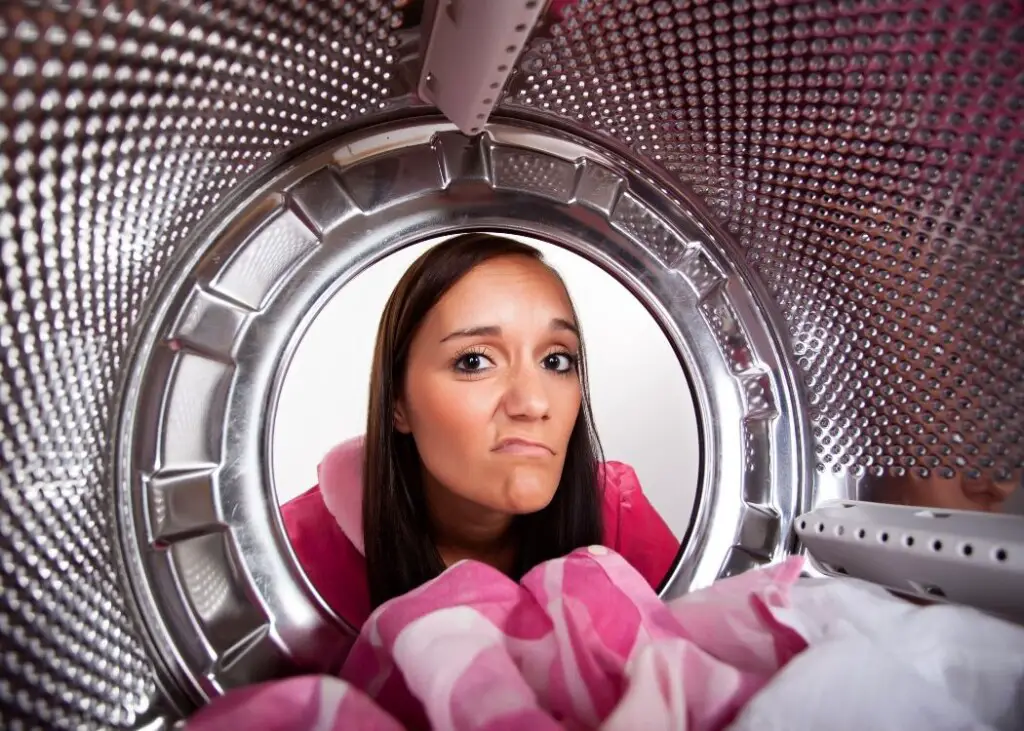Table of Contents
**This page contains affiliate links and I will be compensated if you make a purchase after clicking on my links**
…Like fungi, bacteria, and dust mites
Our sheets are a breeding ground for everything icky. We track in critters from the outside world. Fungi and bacteria will populate in the high humidity created from our sweat under the covers. Dust mites munch on the dead skin we flake off and reproduce in record numbers.
According to WebMD swabs taken from pillowcases, unwashed for only a week, had 17,000 more bacteria than your toilet seat.
(Given all these toilet seat comparisons in the media I’m starting to conclude that toilet seats are relatively clean…)
For most of you, none of this is a concern. You are welcome to live in your filth—we don’t judge.
However, if you suffer from allergies, asthma, skin inflammation, or would like to invite someone to share your bedtime space, then keeping your bedding clean should become a priority.
So why does your bedding stink?
Obviously, it’s not clean. Dust mites and allergens don’t have an odor, but bacteria and fungi do.
But what if you just laundered it?
Let’s take a deeper dive…
Wash bedding regularly
How often should you wash bedding?
According to the Cleveland Clinic, sheets or other bedding that rests against you should be washed at least once every two weeks. Once a week in the warmer, more humid, months—especially if you sweat a lot.
There are other reasons to switch to a weekly wash schedule for your sheets:
- Do you sleep with (messy) children or pets?
- Do you sleep in the nude?
- Do you snack in bed?
For the rest of your bedding—including your pillows—wash at least once every six months.
Dermatologists warn that excess bacteria could aggravate skin conditions such as folliculitis or eczema.
Allergy sufferers need to do more. This includes those with allergic skin conditions such as eczema. According to the Mayo Clinic, we should wash sheets weekly.
And everything else needs to be washed more often, as often as once a week for all bedding, including blankets and bedcovers.
Do you suffer from bad acne? Dirt, dead skin, and bacteria can all clog your pores. According to WebMD, if you are prone to breakouts on your face, change your pillowcases every 2-3 days, and wash the rest of your bedding weekly.
How often should you wash your bedding?
[turn your phone sideways for better viewing]
| wash sheets | wash pillowcases | wash other bedding | |
|---|---|---|---|
| Healthy | every 2 weeks | every 2 weeks | < 6 months |
| Sweat a lot, sleep in the nude, sleep with kids/pets, snack in bed | weekly | weekly | < 6 months? |
| Acne | weekly | change every 2-3 days | weekly |
| Allergies, asthma, including allergic skin disorders | weekly | weekly | weekly |
As always, follow the guidance of your dermatologist or allergist
For allergy sufferers, you can cheat with things like pillows if you encase them in an allergen-blocking cover. Wash the cover weekly and the pillows themselves every six months.

Wash everything in HOT water
Back in the day, there was the “energy crisis” where we were all going to imminently run out of fossil fuels and other sources of energy.
Decades later, we’re all fine, however, habits from those days persist.
One of those habits was to wash everything in cold water to save on heating costs.
Except hot water doesn’t kill bacteria, dust mites, or allergens. Sure, some will rinse away, but most will stick to the fabric.
Back in the day, I used to wash everything in cold water. Including my workout wear.
Then I noticed something strange. I’d put on my “clean” workout wear and wait for my aerobics class to start. In about 5-10 minutes I’d notice that I smelled even though I hadn’t started my workout.
This was just enough time for my body heat to activate the bacteria that was still present on my workout wear.
Initially, I wasn’t bothered by this; I was going to smell anyway after doing my workout.
I compromised and started washing in “warm” water. The problem was better, but still there.
It wasn’t until I switched to washing everything in “hot” that the problem went away, and my clothes smelled clean.
Likewise, allergists recommend washing everything—especially bedding—in hot water at 130º F (54.4º C).
Hot water not only kills allergen-generating critters such as dust mites, but denatures, or breaks apart, the allergen protein that causes our noses to sniffle.
>>For more on removing allergens from your bed and bedroom, see my post HERE.
What about bacteria? According to the CDC, the standard guidance for washing hospital bedding is 160º F (71º C) for at least 25 minutes.
That’s hot! Most of our washers can’t achieve that temperature.
- In an old 1975 study by Walter, et. al., bed linens were contaminated with the bacteria Staphylococcus aureus and washed in various temperatures: 39, 49, 54, and 60º C, followed by standard tumble drying. They found 54º C to be enough to kill the bacteria but recommended 60º C for health care facilities.
Even if our washers don’t get as hot as the CDC recommends, our 55º C hot-water cycle may be enough.
Note that the temperature of rinse water isn’t as critical. To save a little bit of energy, wash in hot water and rinse in cold water.
If you get into bed between freshly laundered sheets and notice body odor 5-10 minutes later, then you didn’t wash away the bacteria from before. Switch to hot water.
How hot is your washing machine water?
I just learned this recently: most washing machines manufactured for the US market do not have an internal heating element to heat the water.
(Evidently, this is a standard feature in washing machines in Europe.)
Here in the US, most likely, your washing machine depends on the hot water coming in from your hot water heater.
There are two problems with this. First, if your washing machine is located far away from your hot water heater, the water will cool as it travels through the pipes. If your washing machine is on the second floor and the hot water heater is in the basement, you are not washing in hot water.
Second, most of us do not have our hot water heaters turned up all the way on purpose. We’re trying to save energy, but more importantly, we don’t want our children (or ourselves) scalded with hot water from the tap.
Fortunately, my washing machine is less than two meters away from my hot water heater in the garage.
I have a washing sink in between the two. I ran the tap on hot and used my handy digital meat thermometer to measure my hot water.
133º F.
I’m good!
Admittedly, I keep my hot water heater on a higher setting as I also want the dishes in my dishwasher clean, and I like hot, jacuzzi-temperature, baths. But it is not on the highest setting.
Keep in mind that scalding of your skin can occur in less than three seconds with water 60º C or 140º F. At my water temperature, it takes longer, at around ten seconds.
Most of my water taps are further away from my hot water source, which allows a few degrees of cooling. So from a safety perspective, I’m right at the edge, but I wouldn’t want to go any higher.
Your mileage may vary.

New washing machines with steam
If you’re in the market for a new washer or dryer, check out some of the new features. In addition to WiFi and other Smart functionality, some new washers and dryers now come with steam.
These washers use a combination of water and steam to clean (or dry) your laundry. You can now clean and sterilize using significantly less hot water than conventional washers.
Steam washers from LG have an Allergiene™ cycle designed specifically to remove allergens. They are certified by the Asthma and Allergy Foundation of America as “asthma & allergy friendly”.
This cycle works by raising the wash temperature temporarily to 131 degrees. This is gentler on clothes and uses less energy than a traditional hot water wash that would stay at that high temperature throughout the entire wash cycle.
(Although not necessarily certified, other steam washers may have similar benefits.)
What about Warm water?
If you absolutely can’t wash in hot water, a 2001 study by Tovey, et. al. showed that washing with detergent at 25º C (only 77º F) was enough to remove most dust mite allergen (Der p 1) and cat allergen (Fel d 1).
(“Warm” wash water may be 86 – 104º F, so well above this temperature.)
Although 25º C might be hot enough to kill dust mite allergen, it’s not hot enough to kill the dust mites themselves. They die above 55º C—in “hot” water.
And as my “experiment” in laundered workout wear demonstrated, hot water is necessary to remove most of the odor-causing bacteria.
Use detergent
In the Tovey study above, the use of detergent was important and worked much better than soap and water alone.
So, when you “wash” in hot water, use detergent.
Laundry additives are fine, such as oxygen bleach, baking soda, or Borax®. But don’t skip the detergent.
Laundry detergent is made mostly of surfactants that work by breaking up and dissolving stains.
These surfactants are amphiphilic: they like to stick to both hydrophilic (“water-loving”) things, as well as hydrophobic (“water-fearing”) things. Grease and oil are hydrophobic, and a surfactant will help dissolve these from fabric and wash them away in the wash water.
Many detergents also include enzymes that break up large molecules such as proteins, starches, and fats.
Other additives soften the water. Softened water helps dissolve soil, plus helps all the other ingredients work better.
For fun, here is the very long list of ingredients in Tide Detergent. A lot of research has gone into this list.
These ingredients are optimized to be used in all wash temperatures, including cold. Older detergents didn’t dissolve well in cold water, leaving residue (and dirt) on clothing.
Yes, there a lot of “home-made” “natural” laundry detergent recipes out there. Just be advised they don’t work as well as commercial laundry detergent.
Use your dryer
Yes, some fabrics (eg, silk) do better left alone. However, if allowed, use your dryer to dry. Some bacteria that survived the wash may meet their end here in the hot dryer.
In the Walter study above, compared to washing alone, measurements of bacteria on bed linens dropped noticeably after tumble drying.
Other sources of heat are also helpful, including steam. Use either a steamer or one of the newer dryers that deliver steam.
If you are one of those rare souls that irons bedding, that will help too. Bless your heart.

What if you’re unable to wash your bedding?
Not everything will survive hot water machine-washing. But a surprising number of things do. I currently machine-wash a pair of silk pillowcases on hot.
Yes, they did shrink a bit the first time, and now have more of a “crushed”, rather than “smooth” silk look. But months later, they are holding up great.
(Obviously, I dry them flat. Unlike water-absorbing cotton, silk dries very fast on its own.)
But I get it. Perhaps you love to sleep under an heirloom quilt or a big fluffy duvet that will never fit in any washer.
When it comes to bacteria, you’ll need to stick with hot water.
However, if your concern is allergens, then there are some things you can do according to the medical experts:
- Wash in warm (86 – 104º F), and rinse twice in cold
- Place your bedding in the freezer overnight. This will kill dust mites or bed bugs but won’t remove the allergens already there.
- Place your bedding in the dryer first on hot (≥ 130º F) to kill the dust mites, then wash as usual to remove the allergens. If you recall from above, most allergens will go away at a warm wash temperature.
- Like the dryer, steaming may also kill dust mites. But again, the allergens will remain unless washed in at least warm water.
- Yes, dry cleaning will kill all dust mites. But unfortunately, dry cleaning is NOT as effective as hot water in removing allergens.
In addition to my workout wear from earlier, I’ve also noticed that dry-cleaned clothes are not necessarily free of body odor either.
Is your washing machine clean?
Is your “clean” laundry smelling musty? It could be your washer itself isn’t clean.
Once you take out your freshly washed laundry do you close the washer door, or leave it open to dry?
If you aren’t letting your washer dry properly, then mildew may be growing between loads.
If you suspect your washing machine is to blame, throw in two cups of white vinegar and run your washer empty. Run a second empty cycle with detergent.
White vinegar is mildly acidic and will dissolve away nasty things. It also works great either in the rinse cycle or as a pre-soak for cotton fabric.
Your washing machine most likely has a “wash machine” setting. Follow the instructions. Mine recommends running chlorine bleach on an empty cycle.
(Although, I’m not a big fan of chlorine bleach.)
Not to brag, but my machine is well over a decade old, and I’ve never needed to use this setting.
Store bedding in a cool dry place
The seasons have changed, and you’ve just pulled out bedding from storage. You laundered it before putting it away. But for some reason, it doesn’t smell clean anymore…
It’s critical that you store bedding in a cool dry place.
>> I go into more detail HERE.
Store your bedding in a breathable container or somewhere with good airflow. If you must use a plastic bin, then throw in some packets of desiccant.
But there is no reason for the plastic bins. Blanket storage bags, made of breathable mesh and see-through plastic panels, are reasonably priced.
If you live in a humid location, eg. greater than 50% humidity, then you are at risk for the growth of mold and mildew.
In this case, you can either try to keep the humidity low with a dehumidifier or accept that your bedding will need to be washed prior to use.
Which is not a bad idea regardless of humidity levels. If your bedding has been sitting on open shelves in a closet it may be dusty at this point.

Use copper or silver infused bedding
If you are concerned about the cleanliness of your bedding, one trend is to purchase bedding with fibers containing either copper or silver.
Copper has been found to inhibit bacteria, fungi, viruses, and even dust mites.
- In a 2004 study by Borkow, et. al. cotton fabric containing 80% regular cotton, and 20% cotton impregnated with copper (“copper cotton”), was exposed to both S. aureus and E. coli (and other nasty bacteria)
- The number of bacteria recovered from the “copper cotton” was significantly reduced compared to that of regular 100% cotton
- Candida albicans (yeast) and Dermatophagoides farinae (dust mites), were also significantly reduced
However, if you purchase copper-infused bedding there’s no guarantee it will work like the experiment above.
Because copper is a good conductor, there is an assumption that copper bedding may be better at conducting heat and keeping you cool. However, there are no studies to support this.
Silver is also good at killing bacteria.
- In a 2009 study by Zhang, et. al., cotton treated with colloidal silver was found to have over a 99% reduction of S. aureus and E. coli after exposure.
Copper or silver imbedded into fabric is designed to withstand multiple washes.
Copper- or silver-infused pillowcases may be a good option for those with acne. One copper pillowcase may be more cost-effective than the 3-7 regular pillowcases you would need to switch out to stay clean during the week between laundry days.
Keep bedroom (and bed) humidity low
Bacteria, fungi, and especially dust mites, love humidity!
Humidity is a measurement of the amount of water in the air. For optimal comfort, we prefer moderate humidity, around 40-60%.
However, medical experts caution us to go a bit lower: the Mayo Clinic recommends 30-50% humidity, especially for those with allergies.
Why so low? Dust mites start to propagate above 50%. And everything else.
>> For more about obtaining the perfect humidity level, see my post HERE.
Purchase an inexpensive hygrometer and check your humidity. (You may already have one, as they are included within fancy thermometers.)
If you live in a dry climate, consider purchasing a humidifier. For a wet climate, a dehumidifier.
Keep your bed humidity low
Just because your bedroom humidity is perfect doesn’t necessarily mean the humidity of your bed is ideal. You and your covers create a unique microclimate.
Most of us like to keep our bedroom temperature cool, and our under-the-covers microclimate on the warm side.
Do you sweat?
If so, you’re significantly adding to the bed humidity.
One solution is to stick with cooling fabrics for both sheets and blankets. I go into great detail HERE.
“Cooling” fabrics are very good at wicking moisture (sweat) away from your skin. This not only cools you off but lowers bed humidity.
Yes, I know, cotton “breathes”. It also holds a lot of moisture.
We all know how long it takes for our cotton sheets and towels to dry in the dryer or on the line. Polyester, silk, and even wool dries instantly in comparison. No dryer needed.
Ironically, this moisture problem makes cotton a terrible fabric for bedding. Your sweat stays with you, raising the bed humidity levels.
At present, my favorite bedding material is lyocell, a natural silk-like fabric derived sustainably from wood pulp.
If you insist on sticking with your cotton bedding an alternative is to use blown air to reduce bed humidity.
This can be accomplished using a BedJet heating and cooling system. This system blows hot or cold air under your covers. Not only can you choose the perfect temperature, but the air carries away that nasty humidity.
Although in a dry winter climate you may get a bit too dry; generous use of body lotion before bed may be required. And keep a water bottle handy on your dresser.
Disclaimer: I recently purchased a BedJet (and I’m also an affiliate). Stay tuned for my upcoming review…
In summary:
- Wash bedding on a schedule
- Wash bedding in HOT water
- Use commercially available detergent
- Use your dryer (bonus if it makes steam!)
- Wash your washer when needed
- Store bedding in a cool dry place
- Keep your bedroom humidity below 50%
- Keep your under-the-covers bed humidity below 50%
First photo credit: Image ©choreograph via Canva.com
Want to learn more about the products mentioned?
[If you experience issues with menus or links not working, it is most likely due to your Ad blocker.]


